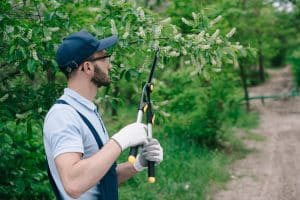

Pruning is a vital practice in horticulture and gardening that involves selectively removing certain plant parts to improve their health, structure, and aesthetics. This article delves into pruning, its benefits, and best practices for pruning plants. Additionally, we recommend three insightful books to help you master the art of pruning.
What is Pruning?
Pruning is the horticultural practice of selectively removing plant parts, such as branches, buds, or roots, to enhance its growth, health, and appearance. This practice is essential for maintaining plant health, controlling shape and size, and encouraging new growth and fruit production. Pruning is not merely about cutting away parts of a plant; it is a strategic process that requires knowledge of plant biology and growth patterns.
What is Pruning a Plant?
Pruning a plant involves the careful and deliberate removal of specific parts to achieve desired outcomes. Whether you are a home gardener or a professional horticulturist, understanding the different types of pruning and their purposes is crucial for successful plant care.
Types of Pruning
- Thinning: Thinning involves removing entire branches back to the main trunk or stem. This type of pruning increases light penetration and air circulation within the plant, reducing disease risk and promoting healthier growth. Thinning is particularly useful for trees and large shrubs.
- Heading: Heading cuts back the terminal portion of a branch to encourage the growth of side shoots. This technique often shapes plants and promotes a denser growth habit. It is commonly applied to hedges and shrubs.
- Deadheading: Deadheading is the removal of spent flowers to encourage additional blooming and prevent the plant from putting energy into seed production. This practice is essential for maintaining the aesthetic appeal of flowering plants and prolonging the blooming period.
- Shearing: Shearing involves trimming the outer edges of a plant to create a specific shape or form. This type of pruning is typically used for formal hedges and topiary.
- Rejuvenation Pruning: This method severely reduces a plant to encourage new, vigorous growth. It is often used on old or overgrown shrubs to renew their vitality.
Benefits of Pruning
- Health and Vigor: Pruning helps remove diseased, damaged, or dead parts of a plant, preventing the spread of disease and pest infestations. It also promotes healthy new growth by allowing more light and air to reach the plant’s interior.
- Aesthetics: Pruning enhances a plant’s visual appeal by shaping it and removing unsightly or overgrown branches. It can transform a garden’s appearance and contribute to its overall design.
- Productivity: Pruning can improve yield for fruiting and flowering plants by encouraging the growth of new, productive branches. It helps direct the plant’s energy towards producing flowers and fruits rather than maintaining excess foliage.
Best Practices for Pruning
- Timing: The best time to prune varies by plant species, but generally, late winter or early spring is ideal for most plants. Pruning during dormancy reduces stress on the plant and minimizes sap loss.
- Tools: Use sharp, clean tools to make precise cuts that heal quickly. Standard pruning tools include pruning shears, loppers, and saws. Ensure tools are sterilized between cuts to prevent the spread of disease.
- Technique: Make cuts at a 45-degree angle above a bud or branch junction. This encourages proper healing and growth. Avoid leaving stubs, which can become entry points for pests and diseases.
- Knowledge: Understand the growth habits and needs of the plants you are pruning. Different plants have different requirements, and improper pruning can harm rather than help.
Book Recommendations
To further your knowledge and skills in pruning, consider these three insightful books:
- “The Pruning Book” by Lee Reich: This comprehensive guide covers all aspects of pruning, from basic techniques to advanced methods. It includes detailed instructions and illustrations for pruning various types of plants, making it an invaluable resource for beginners and experienced gardeners.
- “Pruning and Training” by Christopher Brickell and David Joyce: This book offers practical advice on pruning and training a wide range of plants, including trees, shrubs, climbers, and roses. It features step-by-step instructions and clear diagrams to help you achieve the best results.
- “The American Horticultural Society Pruning and Training” by Christopher Brickell: This authoritative guide provides in-depth information on pruning and training techniques for various plants. It includes expert tips and guidance on creating beautiful and productive gardens.
Pruning is essential for any gardener, offering numerous benefits for plant health, aesthetics, and productivity. By understanding the principles and techniques of pruning, you can ensure your plants thrive, and your garden remains vibrant and beautiful.